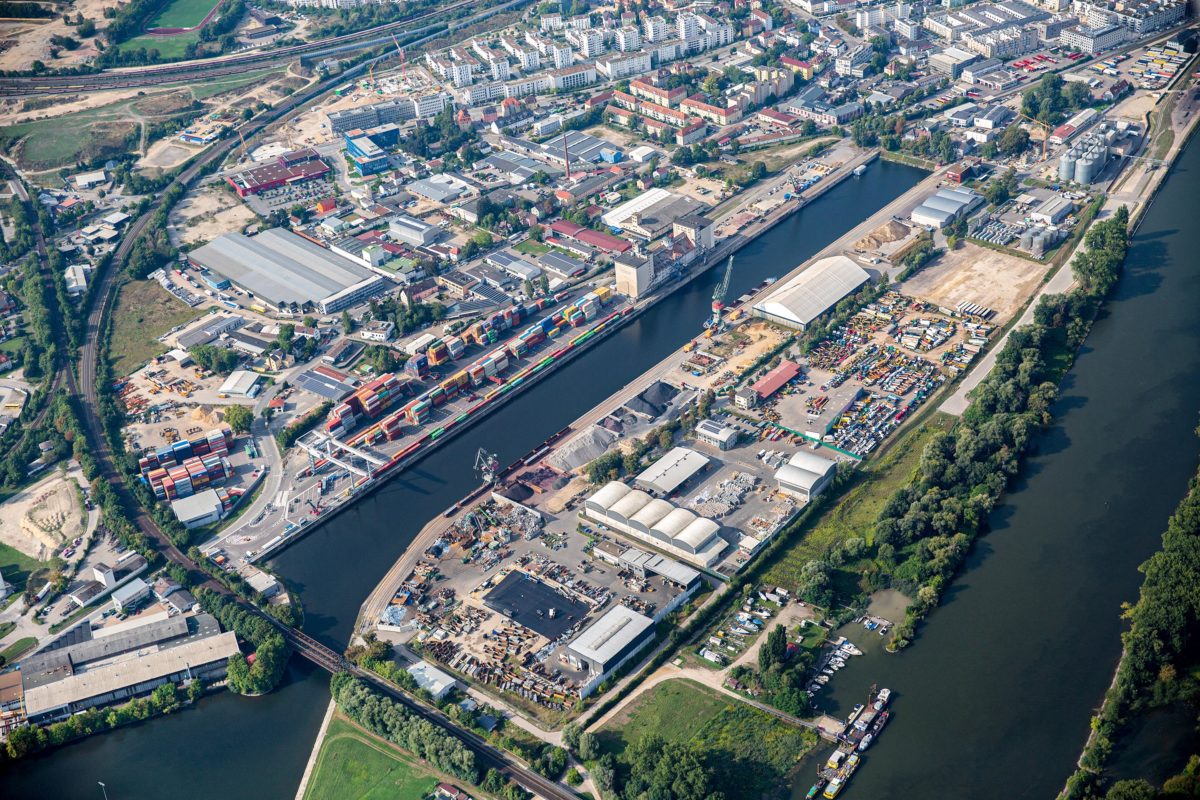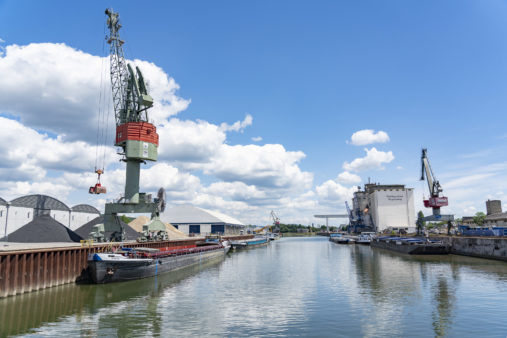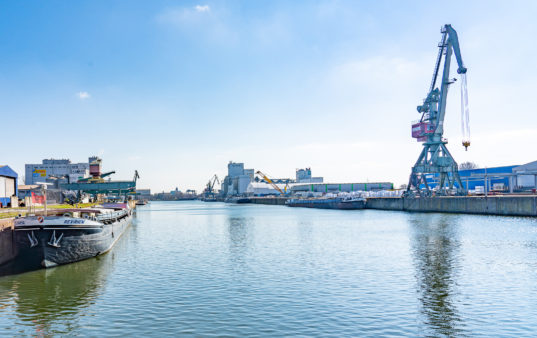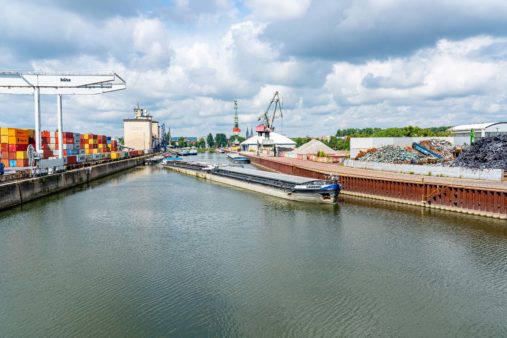13 March 2023 | Regensburg
Investment boost for East Bavaria’s number 1 freight hub
bayernhafen Regensburg in the 2022 financial year: 2.57 million tonnes of goods moved by rail and inland waterway; combined transport throughput up 5.7%; container handling capacity increased to 200,000 TEU

Image: bayernhafen / Herbert Stolz
Container terminal at bayernhafen Regensburg significantly expanded
Regensburg, 13 March 2023 – bayernhafen brings together a diverse range of goods and delivers the right infrastructure to meet the challenge of shifting long-distance traffic from the road networks to the two environmentally friendly transport modes of inland waterway and rail. In 2022, bayernhafen moved almost precisely 9 million tonnes of goods by rail and inland waterway via its six locations of Aschaffenburg, Bamberg, Nuremberg, Roth, Regensburg and Passau – a minimal decrease of 1.8% on the previous year. This corresponds to around 520,000 fewer truck journeys.
In 2022, 2.57 million tonnes of goods were moved by inland waterway and rail at bayernhafen REGENSBURG, amounting to around 92.3% of the volume handled in the previous year.
In 2022, the volume of goods handled by rail at bayernhafen Regensburg was 1.489 million tonnes, 0.4% above the previous year’s level. Regensburg, the leading port in all of Bavaria in the handling of goods by inland waterway, moved 1.083 million tonnes by barge, 16.9% less than in the previous year. Clearly noticeable was the reduction in agricultural goods such as wheat, one of the main commodities transported by barge in Regensburg, as a result of below-average crop yields. There was also a lack of freight capacity because, firstly, less cargo could be transported by river due to prolonged periods of extremely low water and, secondly, shipping capacity was tied up with coal transports on the Rhine and grain transports from Ukraine on the Danube.
There was marked growth in combined transport, which increased 5.7% on the previous year, achieving throughput of 104,734 TEU (twenty foot equivalent unit). In addition to containers for seaport-hinterland traffic, this includes swap bodies and semi-trailers for continental cargo and freight transport.
In order for bayernhafen to remain the first port of call, we must continue to invest in our infrastructure.
Joachim Zimmernann,
Chief Executive Officer of bayernhafen
“Despite the challenges, however, we are seeing considerable interest and a fundamental willingness to expedite the change to inland waterway and rail for transport, not only among our customers but also among companies in Bavaria. To ensure that bayernhafen remains the first port of call, we must continue to invest in our infrastructure, says bayernhafen’s Chief Executive Officer, Joachim Zimmermann.
Reliable supply of goods to the region
In addition to agricultural goods, metal products, ores and building materials are transported by inland waterway from Regensburg. There was a ‘revival’ in 2022 in the handling of coal. High-value heavy-lift cargo such as transformers and wind turbines were also moved by barge. In 2022, more than 100 cable reels were transported to Regensburg via inland waterway and handled and stored by a tracked crane operated by the heavy-lift specialist, Schmidbauer. The cable reels are to be used for transmission system operator TenneT’s SuedOstLink project, which will supply Bavaria with electricity from wind energy generated in the north and east of Germany from 2027 onwards. Rail freight chiefly comprised containers, fuels and construction materials. The supply of heating oil for households and fuels for service stations runs via the VARO tank farm in bayernhafen Regensburg.
First trimodal container terminal in East Bavaria
The expansion of the container terminal at bayernhafen Regensburg has given combined transport a significant boost. The direct connection of the former bi-modal CT terminal (road-rail) to the port basin in the course of the expansion means that inland vessels can now also be directly integrated. This makes bayernhafen Regensburg the only port in the East Bavaria region to have a trimodal container terminal. In addition, a modern, electrically operated container gantry crane was installed. This has increased the handling capacity of the facility operated by CTR Container Terminal Regensburg GmbH, a member of the IGS Logistics Group, which had reached the limits of its capacity, from 128,000 TEU to 200,000 TEU. The project is funded by the Federal Ministry of Digital Affairs and Transport (BMDV).
Following last year’s completion of the flood protection scheme in the waterfront area between the Royal Villa and the Westhafen, another focus is the landscaping of the waterside area connecting the city to the port site.
Carsten Conrad,
Branch Manager of bayernhafen Regensburg
The investment for the entire project amounts to around €26 million. It also includes the construction of a dispatch centre and the addition of two more handling tracks. The road connections were also improved, enabling a more favourable routing of traffic flows. In addition, the check-in area for truck handling was expanded and processes optimised. These measures significantly reduce the load on the access roads. The redevelopment of the area was accomplished by the departure of another company operating from the port with no need to consume additional port land. The developer is KT-Infrastrukturgesellschaft GmbH & Co. KG, a joint venture between IGS and bayernhafen. An efficient logistics infrastructure is indispensable for the highly export-oriented economy in Regensburg and the surrounding region. The container terminal in Regensburg is connected to the North Sea ports in Hamburg and Bremerhaven. bayernhafen Regensburg has a dedicated terminal for the handling of semi-trailers and swap bodies, the Trailer Port.
Investment in infrastructure and projects in 2023
In 2022, bayernhafen continued the high level of investment it had made over the previous years, investing around €3.5 million in Regensburg in the redevelopment of its commercial sites and port infrastructure. A further investment of €10 million is earmarked for 2023. The planned projects include the installation of centralised heating and energy provision for bayernhafen’s office and operations buildings in Linzer Straße. “Following last year’s completion of the flood protection scheme in the waterfront area between the Royal Villa and the Westhafen, another focus is the landscaping of the waterside area connecting the city to the port site, says Carsten Conrad, the Branch Manager of bayernhafen Regensburg. The plan is to continue the re-development of the ‘Danube Promenade’ between Österreicherstadel and Babostraße, to upgrade the western section of the Danube embankment for passenger ships and to optimise the eastern section for cargo handling.
We act as the backbone for the supply of goods to society and industry.
Joachim Zimmernann,
Chief Executive Officer of bayernhafen
This combination of land and infrastructure makes bayernhafen Regensburg a strong anchor point and a major hub for the exchange of goods for the East Bavarian economy. The key prerequisite for this is the clear demarcation between port and residential areas to ensure good neighbourhood relations. “We need protection for our infrastructure. We act as the backbone for the supply of goods to society and industry. This function should not be constrained or even harmed. From urban residential development to conversion for cultural use, there are numerous issues on our agenda that we firmly oppose,” says Joachim Zimmermann.
bayernhafen has asked a series of relevant questions about the technical feasibility study commissioned by the City of Regensburg on the conversion of the Municipal Warehouse into a creative quarter, but we have to date not received any answers. The Municipal Warehouse is located on land owned by Bayernhafen GmbH & Co. KG and is situated directly in the active port operation area with surrounding use of the existing infrastructure on both the rail and water sides. In addition, zoning plan procedures are ongoing for the west port / oil port with the aim of achieving legal clarity and planning reliability out of a cluster of historically conflicting interests – for the benefit of both the customers of the port and for its neighbours.



